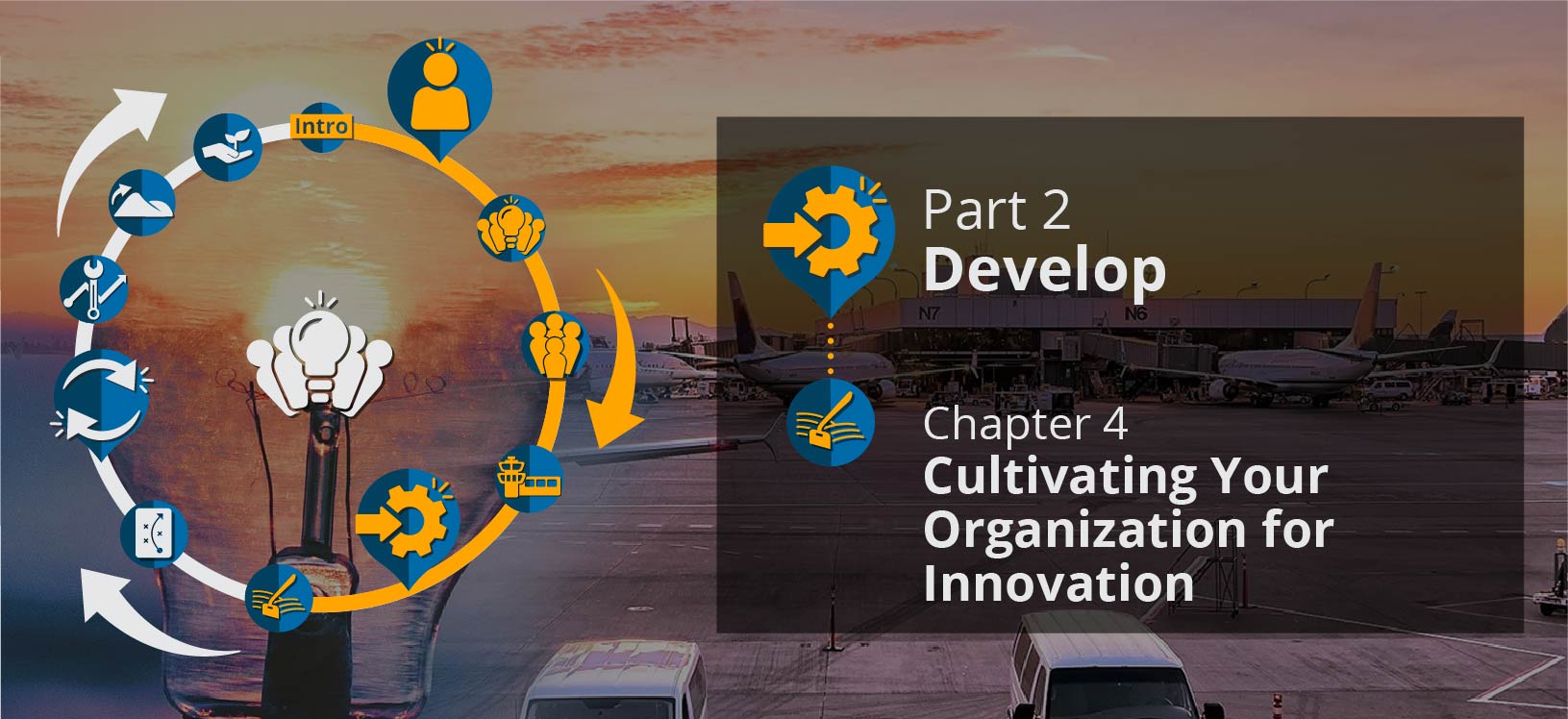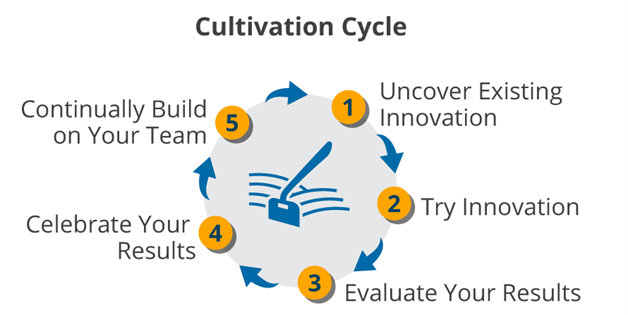

This is a Deep Dive page. Select the chapter for the Fast Track
Cultivation Cycle
You may be part of an organization that does not yet fully appreciate innovation; you may be leading a team that has no desire for a culture change. Perhaps in the past your culture valued innovation, but with the passing of time and change of leadership and priorities, your progress has slowed. Regardless of where you are, there are several things you can do right now to start cultivating your organization to transition to a culture of innovation. Figure D4.1 highlights this cultivation cycle.

Figure D4.1: Cultivation Cycle.
Uncover Existing Innovation
Whether or not you realize it, innovation most likely already exists in your organization or within your team. Go find it!
- Recognize progress you have already made. Start by building a list of all your recent successes (e.g., in the last year) as well as your historic successes (e.g., in the last five years). For each success, ask: Do we know what made these successful? It may have been collaboration, freedom to experiment, having support from leadership, or key staff members stepping up to the plate. Find out the “why” behind these successes.
- Identify your innovators. Get out your organizational chart and identify those who were involved in your list of successes. See if those people also fit these types of personas: catalysts, enablers, accelerators, sustainers, and challengers. Also identify people who, though not directly involved in the successes, are strong drivers of improvements. Identify their character traits as well and flag them as potential candidates for your start-up innovation team (detailed later).
Try Innovation
Find examples you can point to when demonstrating why your organization or team should consider a stronger push toward a culture of innovation.
- Identify a start-up innovation team. It may not be necessary to formally identify this as an “innovation team”; it could be that your whole team is involved. But for larger groups, such as organization-wide efforts, identifying a team can help drive teamwork and commitment to results. Ensure that the team includes a good cross section of positive personas, levels, and business functions. Also include someone who can coordinate the efforts of the group and help ensure accountability.
- Assemble your start-up team to identify your top challenges and needs. While doing so, prioritize the list through an established decision-making/escalation process and pick one or more challenges to solve. (See this Deep Dive page for more information and a definition of the escalation process).
- Leverage existing working relationships and establish new relationships within, across, and outside the organization with partners to help solve the challenge. For example, you may already have established a cross-functional group to address customer experience or operational efficiency issues. Continue using these types of groups; you can decide later whether to evolve this approach.
- Ideate, solve, plan, and implement your solution using the teams and relationships you have put in place. Be sure to work directly with those impacted most by the solutions to identify their business processes and requirements. You might also consider a trial period or pilot program before fully implementing ideas.
Evaluate the Results
Now that you have tried innovating, how did it go? Did you solve the challenges you set out to solve? If not, pinpoint the exact reasons.
- Review how well your ideas solved the challenges. Are they feasible to continue indefinitely? Were they accepted and embraced by those impacted by the solutions?
- Be sure to identify and track any issues arising from the solutions themselves. In order to celebrate the results, you need to continually monitor and improve on what you have done. You may need to have someone regularly gathering information and researching ways to ensure that your solutions are still performing well.
- Take a step back and evaluate the process. During the ideation, solving, planning, and implementation, what lessons learned can you document for the future? One helpful way to draw these out is through a debrief session with key members of the effort. For example, you may have overcome barriers in legal or procurement processes while developing the solution.
- Once you have documented lessons learned, you will have several ideas of new policies and procedures that can build on these new methods for overcoming challenges. Make innovation part of how your organization does business going forward!
Celebrate the Results
Your time and effort have finally paid off, and you have a new idea to share. Your organization or team needs to know what you have accomplished. Highlight team members who worked hard to make success happen.
- Seek out all participants who contributed to a new idea.
- Determine how best to celebrate those participants. Start by asking others who work with them about what motivates them or is meaningful to them.
- Plan the celebration. Get all the details in place, including approvals and logistics.
- Celebrate! Make sure the participants are recognized publicly for their efforts.
Ideas for celebrating include
- Time off: An extra paid day off or even an extra half hour of lunchtime can be rewarding. Giving protected time to work on personal innovation projects can be empowering and demonstrates that time spent innovating is valuable.
- Personal development: Give opportunities to attend external events, visit other airports/organizations, go on a learning tour, or receive training and development.
- Awards: Establish innovation-related awards as part of your airport’s recognition process. This not only recognizes people for their contributions but also demonstrates to the organization that innovation is valued.
- Tangibles: Think about giving out good parking spots for a month, a catered lunch for the innovation team, or an ice cream social for the entire organization to show how everyone is part of the team.
- Day in the life: The chance to spend a day in the life of a colleague can be a fun way to celebrate as well as learn.
- Monetary: If possible, tie direct bonuses or gainsharing to innovative project successes.
- You choose: Give innovators the opportunity to name their “reward.” Generally, staff will not ask for extravagant gifts but rather things like paid parking for a month, an extra hour of time off, or a new coffee maker for the office.
Continually Build on Your Culture of Innovation Team
If you started up an innovation team earlier in this cycle, how is the team doing? If the group has not changed in size or function since it was created, it may be time to rethink your approach. Some ways to ensure that your team is continually evolving and improving include the following:
- Invite new people. Think about all your business functions. Who from each of these functions has not yet participated on the team?
- Invite a whole business unit. Ask a business function to think about how a process or procedure could be improved. This could involve a whole new group joining the team.
- Invite those who are change resistant. Consider those who exhibit the inhibitor or destroyer personas. Find a way to include them, possibly through a challenge that needs to be solved.
- Find new challenges to solve. Come up with a new issue that needs ideating and ask people related to that issue to join the team. You might consider holding a competition to get people inspired.
- Continue to look for opportunities to bring more people to the team. The bottom line is to keep inviting more people to the team so everyone begins to incorporate innovation into not only the group but also their daily tasks.



